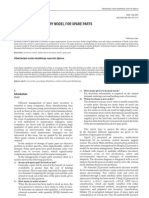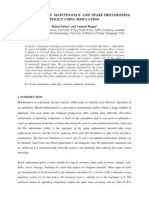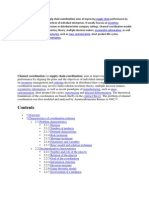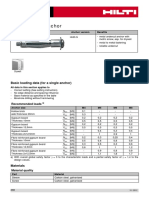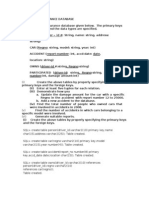Decision Support System For Periodic Review Inventory Model With Backorder Price Discounts Under Controllable Lead Time
Decision Support System For Periodic Review Inventory Model With Backorder Price Discounts Under Controllable Lead Time
Uploaded by
Joko PrasetyoCopyright:
Available Formats
Decision Support System For Periodic Review Inventory Model With Backorder Price Discounts Under Controllable Lead Time
Decision Support System For Periodic Review Inventory Model With Backorder Price Discounts Under Controllable Lead Time
Uploaded by
Joko PrasetyoOriginal Title
Copyright
Available Formats
Share this document
Did you find this document useful?
Is this content inappropriate?
Copyright:
Available Formats
Decision Support System For Periodic Review Inventory Model With Backorder Price Discounts Under Controllable Lead Time
Decision Support System For Periodic Review Inventory Model With Backorder Price Discounts Under Controllable Lead Time
Uploaded by
Joko PrasetyoCopyright:
Available Formats
DECISION SUPPORT SYSTEM FOR PERIODIC REVIEW
INVENTORY MODEL WITH BACKORDER PRICE DISCOUNTS
UNDER CONTROLLABLE LEAD TIME
Ming-Feng Yang
1
, Ming-Cheng Lo
2*
, Chun-Ying Huang
3
1
Department of Transportation Science,
National Taiwan Ocean University, Keelung 202,Taiwan (R.O.C.)
1
yang60429@mail.ntou.edu.tw
2,3
Department of Business Administration,
Ching Yun University,
229, Chien-Hsin Rd., Jung-Li 320, Taiwan(R.O.C).
2
lmc@cyu.edu.tw
*
3
cyhuang@cyu.edu.tw
*corresponding author: Ming-Cheng Lo
ABSTRACT
Lead time reduction has been one of the major factors in the successful
implementation of the popular just-in-time (JIT) inventory system. In many practical
situations, this controllable lead time can be decomposed into several components;
each having a crashing cost for the reduced lead time and the associated crashing
expenses contains a fixed cost and a variable cost per unit product. If an item is out of
stock in an inventory system in which shortage is allowed, the supplier may offer a
negotiable price discount to the loyal, patient and captive customers to compensate for
the inconvenience of backordering. This project studies the integrated inventory
systems with the objective to simultaneously optimizing the order period, lead time,
backorder discount and service level. Because the reduction of inventory cost plays an
important role in production management, this research builds a decision support
system to deal with the optimal reorder point inventory model. In the decision support
system concerning about the inventory model, we take many parameters into account
and help the decision maker to take choice.
Keywords: Lead Time, Crashing Cost, Backorder Price Discount, Service Level,
Decision Support System
INTRODUCTION
Competition features of 90s have evolved into time-based manufacturing (TBM)
(Blackburn 1991). The two time elements considered in TBM are the replenishment
lead time to supply a product to the customer for a specific order and the time to
develop a product from concept to final market delivery. Therefore, reducing lead
time on product supply is the strategic objective of a TBM company (Bockerstette &
Shell, 1993). Although the time compression will inevitably raise the cost, a customer
will pay a premium to the supplier who can furnish its product faster and more
reliably than the competition and the premium may be respectable. Silver, Pyke &
Peterson (1998) defined the replenishment lead time as the time elapsed from the
moment at which it is decided to place an order, until it is physically on the shelf to
Business and Information 2012
(Sapporo, July 3-5)
F 344
satisfy customer demands. Although lead time can be a constant or a random variable,
it is often treated as a prescribed parameter [3, 4]; thus not controllable. However,
lead time can be reduced at extra cost and shorter lead time is the primary driver to
achieving customer satisfaction in successful TBM operations Bockerstette & Shell,
1993). The benefits resulting from reduced lead time include lower cost, less waste
and less obsolescence, greater flexibility to response to change, closely linked
organization priorities to customers needs, improved service, quality and reliability,
and substantially accelerated supply system improvements (Blackburn 1991). Tersine
(1994) and Vollmann, Berry & Whybark (1992) attributed the replenishment lead time
mostly to manufacturing considerations and addressed some guidelines for its
reduction. Liao & Shyu (1991) suggested that lead time could be decomposed into n
components each having a different crashing cost for reduction. Ben-Daya & Raouf
(1994) generalized the Liao & Shyu (1991) model by considering both lead time and
the order quantity as decision variables.
Ouyang, Yen & Wu (1996) extended the Ben-Daya & Raoufs(1994) model to
include a mixture of backorder and lost sales in the model by assuming a
predetermined service level with both reorder point and backorder rate being fixed.
Moon & Choi (1998) suggested that it was not appropriate to include the service
constraint if the shortage cost was explicitly specified and claimed that a better
solution could be obtained by allowing the reorder point to be variable. Hariga and
Ben-Daya (1999) also revised Ouyang et al. (1996) model by including the reorder
point as a decision variable. Ouyang & Wu (1998) relaxed the assumption on the form
of cumulative distribution function of the lead time demand and applied the minimax
distribution free procedure to solve the problem. Pan and Hsiao (2001) presented two
inventory models where shortage was allowed with controllable back ordering.
This research considers a periodic review inventory system in which the lead
time is controllable and can be decomposed into several components each having a
crashing cost function. In addition, shortage is permitted and the total amount of
stockout is a combination of backorder and lost sale. It is further assumed that the
patient customers with outstanding orders during the shortage period are offered a
backorder price discount and consequently the backorder ratio is proportional to the
magnitude of this discount (Pan & Hsiao, 2001). Ouyang, Chuang, & Lin (2003)
extended Pan & Hsiao (2001) model by including the consideration of backorder
discounts under periodic review model. Since the shortage cost is explicitly included,
the reorder point is also treated as a decision variable in this paper (Moon &
Choi ,1998). Sprague & Carson (1982) thought a complete framework of decision
support system should include Data Base, Model Base and Software System. Next we
construct a decision support system to analysis the inventory model, then find out the
Business and Information 2012
(Sapporo, July 3-5)
F 345
best choice with period review time, backorder discount and lead time. Once we build
the decision support system, we can use the result to apply into other inventory model
and adjust the parameter to fit the other different inventory situations.
NOTATIONS AND ASSUMPTIONS
The following notations and assumptions are made in this research:
Notations
L = the length of lead time (decision variable);
T = length of a review period (decision variable);
t
x
= backorder price discount offered by the supplier per unit (decision variable);
k = safety factor (decision variable);
r = the reorder point;
t
0
= the gross marginal profit per unit;
D = average demand per year;
A = fixed ordering cost per order;
h = inventory holding cost per unit per year;
= the average demand rate in units/day;
| = the backorder ratio;
|
0
= the upper bound of the backorder ratio;
| = The standard normal distribution
= The standard normal cumulative distribution function
X = The lead time demand which has a distribution function (d. f.) F(x) with finite
mean DL and standard deviation L
1/2
, where denotes the standard deviation
of the demand per unit time
E() Mathematical expectation
x
+
= Maximum value of x and 0, that is x
+
= max{x,0}
Assumptions
1. The inventory level is reviewed every T units of time. A sufficient quantity is
ordered up to the target level r. The target level r = expected demand during lead
time + safety stock, that is, r = D(T+L) + ko L T + , where k is a nonnegative
safety factor.
2. The lead time L has n mutually independent components, where the ith
component has a normal duration T
i
and a minimum duration t
i
, i = 1, 2, , n and
a crashing cost per unit time a
i
. These a
i
's are arranged such that a
1
s a
2
s s a
n
.
The lead times are crashed one component at a time starting with the one of least
c
i
, and so on.
3. Let L
i
denote the length of lead time with component 1, 2, , i crashed to their
minimum values, then L
i
can be expressed as L
i
=
1
n
j
j
U
=
1
( ).
i
j j
j
U u
=
Thus,
the lead time crashing cost R(L) per replenishment cycle is given by
R(L) = a
i
(L
i1
L) +
1
1
( )
i
j j j
j
a U u
, for L e [L
i
, L
i1
].
4. The backorder ratio | is variable and is in proportion to the backorder price
discount offered by the supplier per unit t
x
; thus, | = |
0
t
x
/t
0
, for 0 < |
0
s 1, 0 s
t
x
s t
0
(Pan & Hsiao, 2001).
DECISION SUPPORT SYSTEM
Business and Information 2012
(Sapporo, July 3-5)
F 346
Sprague & Carson (1982) thought a complete framework of decision support
system should include the following events shown as figure 1:
Data BaseStore up the data that the decision support system requires.
Model BaseStore up the data analysis model and decision analysis model or
view these models as sub-patterns which are independent with each other.
Software SystemThe software system includes the following three subsystems.
Data Base Management Subsystem, DBMSs.
Model Base Management Subsystem, MBMSs.
Dialog Generation and Management Subsystem, DGMSs.
System Analysis
Data base Model base
MBMSs
DGMSs
DBMSs
Figure 1 DSS System Framework
Business and Information 2012
(Sapporo, July 3-5)
F 347
System Framework
Setup Cost Data
Ordering Cost
Data
Backorder Data
Crashing Cost
Data
Holding Cost
Data
Normal Demand
Cost Model
Distrbution Free
Demand Cost
Model
Uncertainty factors
Database system
Model management
system
User platform
Cost data
Model data
Figure 2 System framework
NORMAL DEMAND MODEL
The problem under study is to minimize the following total expected annual cost:
EAC(T, t
x
, k, L) = OC + HC + SC + CC
where OC stands for ordering cost, HC for holding cost, SC for shortage cost,
and CC for crashing cost. Consequently, the total expected annual cost EAC(T, t
x
, k,
L) is
EAC(T, t
x
, k, L) )] ( T ) 1 ( T
2
DT
[
T
A
k L L k h + + + + + + = o | o
) ( ] ) 1 ( [
1
0
k L T
T
x
+ + + + o t | |t
Business and Information 2012
(Sapporo, July 3-5)
F 348
(
+ +
1
1
1
) ( ) (
1
i
j
j j j i i
t T a L L a
T
for L
i
s L s L
i1
(1)
Taking the first partial derivatives of EAC(T, t
x
, k, L) with respect to T t
x
, k and
L, respectively, it follows that
2 0
0 0
2
0
EAC( , , , )
2
( )
2
x
x x
T
T L
T k L hk
T L
k
T T T L
t | o
t t | t o
t
+
( c
+
= + +
(
c +
1
1 2 2
1
1
( ) ( )
T 2 T
i
i i i j j
j
A hD
a L L a T t
=
(
+ +
(
(2)
0 0
x 0
0 0
EAC( , , , ) 2 1
= ( ) ( )
x
x
T k L
h T L k T L k
T
t | |
t | o
t t t
( c
+ + + + +
(
c
(3)
0
0
2 0
0 0
0
1
EAC( , , , )
(1- ( ))
x
x
x x
h
T k L
h T L T L k
k
T
|
t
t
t
o o
|
t t | t
t
(
| |
( |
c \ .
(
= + + u
(
c
| |
(
+ +
|
(
\ .
(4)
( ) ( ) ( )
0
1 1
0
2 2
2 0
0
0
1
EAC( , , , ) 1 1 1
4 2
1
x
x
x x
h
T k L
L T k hk L T
L T
T
|
t
t
t
o o
|
t |t
t
(
| |
( |
c \ .
(
= + + + +
(
c
| |
(
+
|
(
\ .
(5)
Setting equation (4) to zero and solving for t
x
, it follows that
0
2
x
hT t
t
+
= (6)
Setting equation (3) to zero and substituting (6) into (3) to solve for T, thus
( ) ( ) ( ) 0
4
1 2
2
1
0
0
0
0 2
=
(
+ + + |
.
|
\
|
+
|
|
.
|
\
|
+ + L R k L T A k L T
D
h
Dh T o
|
t o
t
|
(7)
Setting equation (4) to zero and substituting (6) into (4) to solve for k, then
( )
(
|
|
.
|
\
|
|
.
|
\
|
+ +
= u
4
1
4
1
)
2 2
1 (
1 ) (
0
0
2
0
0 0
0
0
|
t
t
| |
t
|
hT
T
hT
h
h
k
(8)
It can be shown from (8) that hT s t
0
, so u(k) > 0.5 holds for nonnegative safety
Business and Information 2012
(Sapporo, July 3-5)
F 349
factor k. Consequently, the value of t
x
derived in (6) will automatically be positioned
between 0 and t
0
as specified in assumption 4.
DISTRIBUTION FREE MODEL
In a distribution free model, the lead time demand assumption is relaxed to any
distribution function by only assuming that the distribution function F belongs to the
class with finite mean DL and variance o
2
L. Again, the expected total annual cost
of the model can be expressed as EAC(T, t
x
, k, L) = OC + HC + SC + CC. While the
expected ordering and expected crashing costs are of the same forms as those of the
normal demand model, the expected shortage at the end of a cycle can be expressed
by B(r) = E[X r]
+
the expected total annual cost can be presented by
0
1
1
1
DT
EAC( , , , ) T (1 ) [ ]
T 2
1
[ (1 ) ] [ ]
T
1
( ) ( )
T
x
x
i
i i j j j
j
A
T k L h k L E X r
E X r
a L L a T t
t o |
|t | t
+
+
=
(
= + + + +
(
+ +
(
+ +
(
for L
i
s L s L
i-1
(9)
Since the form of the lead time demand distribution is not known, the minimax
criterion is applied to find the least favorite distribution function inOfor each (T, t
x
, k,
L) and then find the optimal values of T
*
, t
x
*
, k
*
and L
*
that minimize the expected total
annual cost. In mathematical symbolization, the problem under investigation can be
expressed as
O e > > F L Q
max min
0 , 0
EAC(T, t
x
, k, L)
Gallego & Moon (1993) proved that the following inequality holds for any F e
O,
| | ) ) (T ( ) ) (T ( ) (T
2
1
) ( E
2 2
L D r L D r L r X + + + + s
+
o (10)
Substituting r = DL + ko L into the model, the problem can be reduced to
minimize
1
1
1
0
0
2
2 0
0 0
0
A DT 1
EAC( , , , ) T ( ) ( )
T 2 T
1
1
T ( 1 )
2
1
T
i
x i i j j j
j
x
x x
T k L h k L a L L a T t
h
L k k
t o
|
t
t
o
|
t t | t
t
=
(
(
= + + + + +
(
(
(
(
+ + +
`
(
+ +
(
)
for L
i
s L s L
i1
(11)
Business and Information 2012
(Sapporo, July 3-5)
F 350
Taking the partial derivatives of EAC(T, t
x
, k, L) with respect to T, t
x
, k and L in
each time interval [L
i
, L
i1
] in (11), we obtain
( )
2
2 2 0
0 0
2
0
1
1
2
1
EAC( , , , )
T 2 2
2
1
2
1
( ) ( )
T
x
x x
i
i i i j j
j
T k L A hD hk
T T L
T
T L
T L
k k
T
a L L a T t
t o
|
t t | t o
t
=
c
= + +
c +
+
(
+
+ +
(
(
+
(
(12)
) , , , EAC(
x
x
L k T
t
t
c
c
= ( ) k k L T
T
k L T h + +
(
+ + +
2
0 x
0
0
0
0
1
2
2
1
) ( o | t
t
|
t
|
(13)
0
0
2 2 0
0 0
0
1
EAC( , , , ) 1
(1- )
2
1
x
x
x x
h
T k L k
h T L T L
k
k
T
|
t
t
t
o o
|
t t | t
t
(
| |
( |
\ .
(
c
(
= + +
| |
c
(
+ +
|
(
\ .
+
(
(14)
( )
( )
( )
0
0
1
0
2
2
2
0
0
1
2
1
EAC( , , , ) 1
1
8
1
1 1
2
x
x
x x
h
T k L
L T k k
L
T
hk L T
T
|
t
t
t
o
|
t | t
t
o
(
| |
( |
c \ .
(
= + +
(
c
| |
(
+
|
(
\ .
+ +
(15)
Setting equation (13) to zero and solving for t
x
, it follows that
0
2
x
hT t
t
+
= (16)
Setting equation (12) to zero and substituting (16) into (12) to solve for T, it
follows that
( )
( )
( )
2 2 0
0
2 0 0
1 1
4
2 1 1 0
2 4
h
T Dh T L k k
D
A T L k k R L
|
o
t
t |
o
| |
+ +
|
\ .
(
| |
+ + + + =
| (
\ .
(17)
Business and Information 2012
(Sapporo, July 3-5)
F 351
Solving for k by setting equation (14) to zero and substituting (16) into (14), we have
( )
(
(
|
|
.
|
\
|
|
|
.
|
\
|
+ +
=
+
4
1
4
1
)
2 2
1 (
2
1
1
0
0
2
0
0 0
0
0
2
|
t
t
| |
t
|
hT
T
hT
h
h
k
k
(18)
The following algorithm can be used to find the optimal values of the order
quantity, backorder discount, reorder point and lead time.
Step 1. For i = 0, 1, 2, , n
(i) Set k
io
= 0
(ii) Substitute k
io
into (17) to evaluate T
io
.
(iii) Use T
io
to determine k
in
from (18), then find k
in
. Let k
io
= k
in
.
(iv) Repeat (ii) and (iii) until no change occurs in the values of T
i
and k
i
.
Denote these resulting solutions by T
i
and k
i
.
(v) Use T
i
and equation (16) to compute the backorder price discount t
xi
.
(vi) Use equation (1) to compute the expected total annual cost EAC(T
i
, t
xi
,
k
i
, L
i
).
Step 2. Set EAC(T
*
, t
x
*
, k
*
, L
*
) = Min{EAC(T
i
, t
xi
, k
i
, L
i
), i = 0, 1, 2, , n}
Step 3.(T
*
, t
x
*
, k
*
, L
*
) is a set of optimal solutions.
Numerical Example
Consider an inventory system with the following data: D = 600 units/year, A =
$200 per order, h = $20 per unit per year, t
0
= $150 per unit, o = 7 unit/week, and the
lead time has three components with data shown in Table 1 (Pan & Hsiao, 2001).
Apply the proposed algorithm to solve the problem for the upper bound of the
backorder ratio |
0
= 0.95, 0.80, 0.65, 0.50, 0.35 and 0.20, respectively. The resulting
optimal solutions are summarized in Table 2 and Table 3.
Table 1. Lead time data of the examples
Lead time component i 1 2 3
Normal duration U
i
(days) 20 20 16
Minimum duration u
i
(days) 6 6 9
Unit fixed crashing cost a
i
($/day)
0.4 1.2 5.0
Business and Information 2012
(Sapporo, July 3-5)
F 352
Table 2. Summary of the results for Example in Normal Demand (
i
L in weeks)
L
0
|
i 0 1 2 3
L
i
8 6 4 3
0.2
T
24.75 23.41 21.85 21.14
t
x
79.76 79.50 79.20 79.07
k
1.53 1.53 1.53 1.53
EAC(T, t
x
, k, L)
4916.69 4753.27 4596.42 4582.02
0.35
T
24.32 23.02 21.50 20.83
t
x
79.68 79.43 79.13 79.01
k
1.52 1.52 1.52 1.52
EAC(T, t
x
, k, L)
4884.67 4726.44 4576.32 4566.46
0.50
T
23.89 22.62 21.15 20.50
t
x
79.59 79.35 79.07 78.94
k
1.50 1.50 1.50 1.50
EAC(T, t
x
, k, L)
4852.73 4699.84 4556.59 4551.34
0.65
T
23.45 22.22 20.79 20.18
t
x
79.51 79.27 79.00 78.88
k
1.49 1.49 1.49 1.49
EAC(T, t
x
, k, L)
4820.93 4673.50 4537.29 4536.70
0.80
T
23.01 21.81 20.42 19.85
t
x
79.42 79.19 78.93 78.82
k
1.47 1.47 1.47 1.47
EAC(T, t
x
, k, L)
4789.29 4647.49 4518.47 4522.60
0.95
T
22.55 21.39 20.05 19.51
t
x
79.34 79.11 78.86 78.75
k
1.45 1.45 1.45 1.45
EAC(T, t
x
, k, L)
4757.88 4621.86 4500.20 4509.10
Business and Information 2012
(Sapporo, July 3-5)
F 353
Table 3 Summary of the results for Example in Distribution Free Demand (
i
L in
weeks)
L
0
|
i 0 1 2 3
L
i
8 6 4 3
0.2
T
27.32 25.80 23.98 23.09
t
x
80.25 79.96 79.61 79.44
k
2.55 2.62 2.72 2.77
EAC(T, t
x
, k, L)
5895.09 5634.61 5351.24 5250.03
0.35
T
26.84 25.35 23.58 22.72
t
x
80.16 79.88 79.53 79.37
k
2.55 2.62 2.71 2.76
EAC(T, t
x
, k, L)
5844.37 5589.60 5313.98 5218.28
0.50
T
24.82 23.48 21.91 21.20
t
x
79.77 79.52 79.21 79.08
k
2.52 2.58 2.65 2.69
EAC(T, t
x
, k, L)
5635.76 5405.93 5163.83 5091.59
0.65
T
25.85 24.43 22.76 21.97
t
x
79.97 79.70 79.38 79.23
k
2.54 2.60 2.69 2.73
EAC(T, t
x
, k, L)
5741.23 5498.49 5239.08 5154.82
0.80
T
25.34 23.96 22.34 21.59
t
x
79.87 79.61 79.30 79.15
k
2.53 2.59 2.67 2.71
EAC(T, t
x
, k, L)
5688.79 5452.39 5201.49 5123.16
0.95
T
24.82 23.48 21.91 21.20
t
x
79.77 79.52 79.21 79.08
k
2.52 2.58 2.65 2.69
EAC(T, t
x
, k, L)
5635.76 5405.93 5163.83 5091.59
Business and Information 2012
(Sapporo, July 3-5)
F 354
CONCLUSIONS
This paper extends the Pan and Hsiao model (Pan & Hsiao, 2001) to study the
impact of safety factor on the periodic review inventory model involving controllable
lead time and backorder price discount with mixture of backorder and partial lost
sales. The objective is to minimize the expected total annual cost by simultaneously
optimizing order period, backorder price discount, safety factor and lead time. There
are two models considered in the plan, one with normal demand distribution and
another with general demand distribution having both mean and variance known and
finite. Algorithms are developed to find the optimal solutions for the two models and
examples are provided to illustrate the procedures of the algorithms. We construct a
decision support system to analysis the inventory model, then find out the best choice
with period review time, backorder discount and lead time. Once we build the
decision support system, we can use the result to apply into other inventory model and
adjust the parameter to fit the other different inventory situations. The calculation of
the expected value of additional information for the distribution free problem are
demonstrated in the examples as well.
Business and Information 2012
(Sapporo, July 3-5)
F 355
REFERENCES
Ben-Daya, M. & Raouf, A. 1994. Inventory models involving lead time as a decision
variable. Journal of the Operation Research Society. 45, 579-582.
Blackburn, J. D. 1991. Time-Based Competition: The Next Battleground in American
Manufacturing. Homewood, Illinois: Business One Irwin.
Bockerstette, J. A. & Shell, R. L. 1993. Time Based Manufacturing, New York:
McGraw-Hill.
Gallego, G. & Moon, I. 1993. The distribution free newsboy problem: Review and
extensions, Journal of the Operational Research Society, 44, 825-834.
Hariga, M. A. & Ben-Daya, M. 1999. Some stochastic inventory models with
deterministic variable lead time. European Journal of Operational Research. 113,
42-51.
Liao, C. J. & Shyu, C. H. 1991. Analytical determination of lead time with normal
demand. International Journal of the Operational Research and Production
Management, 11, 7278
Moon, I. & Choi, S. 1998. A Note on lead time and distribution assumptions in
continuous review inventory models. Computers and Operations Research. 25,
1007-1012.
Naddor ,N. 1996. Inventory System. New York: John Wiley.
Ouyang, L. Y. Yen, N. C. & Wu, K. S. 1996. Mixture inventory model with
backorders and lost sales for variable lead time. Journal of the Operation
Research Society, 47, 829-832.
Ouyang, L. Y. & Wu, K. S. 1998. A minimax distribution free procedure for mixed
inventory model with variable lead time. International Journal of Production
Economics. 56, 511516.
Ouyang, L. Y. Chuang, B.R. & Lin, Y. J. 2003. Impact of backorder discounts on
periodic review inventory model. International Journal of Information and
Management Sciences. 14(3), 1-13.
Pan, J. C. & Hsiao, Y. C. 2001. Inventory models with backorder discounts and
variable lead time. International Journal of Systems Science. 32, 925929.
Silver, E. A. Pyke, D. F. & Peterson, R. 1998. Inventory Management and Production
Planning and Scheduling, 3/e. New York: John Wiley.
Sprague, R H. & Carson, E. D. 1982. Building Effective Decision Support System.
Prentice-Hall.
Tersine, R. J. 1994. Principles of Inventory and Material Management. New York:
North Holland.
Vollmann, T.E., Berry, W.L. & Whybark, D.C. 1992. Manufacturing Planning and
Control System 3/e. Chicago: Irwin.
Business and Information 2012
(Sapporo, July 3-5)
F 356
You might also like
- Us Army Helicopter MaintenanceDocument296 pagesUs Army Helicopter MaintenanceDave Gagliostro100% (5)
- Maintenance and Operational Reliability: 24 Essential Building BlocksFrom EverandMaintenance and Operational Reliability: 24 Essential Building BlocksNo ratings yet
- Centaurus-Gulraiz GulzarDocument6 pagesCentaurus-Gulraiz Gulzargulraiz gulzarNo ratings yet
- GM1927-35 Run at Rate (GP9) ProcedureDocument9 pagesGM1927-35 Run at Rate (GP9) Procedurejb_coelhoNo ratings yet
- Two Echleon by JHa JKDocument9 pagesTwo Echleon by JHa JKaggarwalankit911No ratings yet
- Writing SampleDocument13 pagesWriting SampleMonika Aditia PutriNo ratings yet
- Louly Dolgui 2002 IglsDocument6 pagesLouly Dolgui 2002 IglsKate Marulanda JimenezNo ratings yet
- Modelo de Inventario Periodico Con Costo Por Pedido Reducido Bajo Restriccion de Nivel de ServicioDocument13 pagesModelo de Inventario Periodico Con Costo Por Pedido Reducido Bajo Restriccion de Nivel de ServicioLuisa SehuanezNo ratings yet
- Integrated Vendor-Buyer Cooperative Inventory Models With Controllable Lead Time and Ordering Cost ReductionDocument15 pagesIntegrated Vendor-Buyer Cooperative Inventory Models With Controllable Lead Time and Ordering Cost ReductionmohanpusNo ratings yet
- Mathematical and Computer Modelling: Minjae Park, Hoang PhamDocument16 pagesMathematical and Computer Modelling: Minjae Park, Hoang PhamMubashir UnnissaNo ratings yet
- What Is InventoryDocument7 pagesWhat Is Inventorydeepmangal222No ratings yet
- Customer Lead Time Management When Both Demand and Price Are Lead Time SensitiveDocument13 pagesCustomer Lead Time Management When Both Demand and Price Are Lead Time Sensitive007mbsNo ratings yet
- Q1. Safety Stock Determination Based On Parametric Lead TimeDocument18 pagesQ1. Safety Stock Determination Based On Parametric Lead TimeFaridz Mohammad EdrieNo ratings yet
- Product PostponementDocument14 pagesProduct PostponementChitresh231No ratings yet
- End-of-Period vs. Continuous Accounting of Inventory-Related CostsDocument11 pagesEnd-of-Period vs. Continuous Accounting of Inventory-Related CostsJuan David Arias SuárezNo ratings yet
- DOC-20230517-WA0028Document6 pagesDOC-20230517-WA0028layansafsouf1No ratings yet
- Song Zhao MSOM 09Document16 pagesSong Zhao MSOM 09Crystal StoneNo ratings yet
- Cost System Design FinalDocument6 pagesCost System Design Finallayansafsouf1No ratings yet
- Manufacturing Lead Times, Order Release and Capacity LoadingDocument43 pagesManufacturing Lead Times, Order Release and Capacity Loading孫ウィーユNo ratings yet
- Economic Order QuantityDocument7 pagesEconomic Order QuantityShuvro RahmanNo ratings yet
- 9.+247114 Proof DoneDocument10 pages9.+247114 Proof Donerim zamzamiNo ratings yet
- 56 FBBCFDD 01Document12 pages56 FBBCFDD 01Sri Susilawati IslamNo ratings yet
- Periodic Review Inventory Model WithDocument18 pagesPeriodic Review Inventory Model WithDr-Mohammed FaridNo ratings yet
- Partcipacion 3..Document11 pagesPartcipacion 3..Ivonne CMNo ratings yet
- Note A Separation Principle For A Class of AssemblDocument13 pagesNote A Separation Principle For A Class of Assemblvaddi santosh kumarNo ratings yet
- Integrated Inventory and Transportation Mode Selection: A Service Parts Logistics SystemDocument19 pagesIntegrated Inventory and Transportation Mode Selection: A Service Parts Logistics Systemmasalac543No ratings yet
- European Journal of Operational Research: Anderson J. Brito, Adiel T. de AlmeidaDocument11 pagesEuropean Journal of Operational Research: Anderson J. Brito, Adiel T. de AlmeidaMustafa FarragNo ratings yet
- Chapter VI. Independent Demand Inventory SystemsDocument12 pagesChapter VI. Independent Demand Inventory Systemssimi1690No ratings yet
- Inventory Control in Closed Loop Supply Chain Using System DynamicsDocument33 pagesInventory Control in Closed Loop Supply Chain Using System DynamicsAritra SenNo ratings yet
- On The Optimality of Inventory Models With Deteriorating Items For Demand and On-Hand Inventory Dependent Production RateDocument20 pagesOn The Optimality of Inventory Models With Deteriorating Items For Demand and On-Hand Inventory Dependent Production RateAzz Arfan RissNo ratings yet
- Metrics Paper 19july96 PDFDocument20 pagesMetrics Paper 19july96 PDFfronendNo ratings yet
- Optimal Lot SizingDocument17 pagesOptimal Lot SizingHansenNo ratings yet
- Optimal Replenishment Policies With Allowable Shortages For A Product Life CycleDocument13 pagesOptimal Replenishment Policies With Allowable Shortages For A Product Life Cycle翁慈君No ratings yet
- Cordination in SCM Research Paper.Document15 pagesCordination in SCM Research Paper.punamcheberwalNo ratings yet
- Dynamic Inventory Lot SizeDocument13 pagesDynamic Inventory Lot SizeOtieno MosesNo ratings yet
- Dynamic Optimization Model For Mining Equipment ReDocument11 pagesDynamic Optimization Model For Mining Equipment ReMantenimiento MineroNo ratings yet
- Inventory Theory (Quantitative Techniques)Document41 pagesInventory Theory (Quantitative Techniques)Lexter Smith Albay100% (2)
- Mathematical Modelling For Multiproduct EPQ Problem Featuring Delayed Differentiation, Expedited Rate, and ScrapDocument21 pagesMathematical Modelling For Multiproduct EPQ Problem Featuring Delayed Differentiation, Expedited Rate, and ScrapMiles de AlaskaNo ratings yet
- Calculation of The Reorder Point For Items With Exponential and Poisson Distribution of Lead Time DemandDocument10 pagesCalculation of The Reorder Point For Items With Exponential and Poisson Distribution of Lead Time DemandRaj ChauhanNo ratings yet
- 38 Standard CostingDocument96 pages38 Standard CostingSamuel DwumfourNo ratings yet
- Inventory Model With Time Dependent Demand Rate Under Inflation When Supplier Credit Linked To Order QuantityDocument14 pagesInventory Model With Time Dependent Demand Rate Under Inflation When Supplier Credit Linked To Order QuantityAkshay BhattNo ratings yet
- Suministro de Repuestos Basado en CondicionDocument9 pagesSuministro de Repuestos Basado en CondicionDaniel Carvajal TinocoNo ratings yet
- Inventory Management: Some Terms and DefinitionsDocument6 pagesInventory Management: Some Terms and DefinitionsRaj ChauhanNo ratings yet
- A Multi-Criterion Decision-Making On Preventive MaintenanceDocument9 pagesA Multi-Criterion Decision-Making On Preventive Maintenanceieom2012No ratings yet
- Multicriteria Inventory Model For Spare Parts PDFDocument6 pagesMulticriteria Inventory Model For Spare Parts PDFsaeedalemveNo ratings yet
- Msom InventInventory Pooling To Deliver Differentiated Serviceory Pooling InformalDocument30 pagesMsom InventInventory Pooling To Deliver Differentiated Serviceory Pooling InformalmarcelojscostaNo ratings yet
- 2 AspDocument25 pages2 AspRusu IrinaNo ratings yet
- E-Business and Circular Supply ChainsDocument24 pagesE-Business and Circular Supply ChainsNipun BansalNo ratings yet
- 1 Joint - Optimization - of - LORA - and - Spares - Stocks - Considering - Corrective - Maintenance - Time, 2013Document11 pages1 Joint - Optimization - of - LORA - and - Spares - Stocks - Considering - Corrective - Maintenance - Time, 2013Clovis NetoNo ratings yet
- Vol3 Iss4 390 - 395 Decision-Making For A Single Item EDocument6 pagesVol3 Iss4 390 - 395 Decision-Making For A Single Item ESaketh ReddyNo ratings yet
- Full Name: Pham Thi Khanh Linh POM Chapter 3 Process StrategyDocument10 pagesFull Name: Pham Thi Khanh Linh POM Chapter 3 Process StrategyThi Khanh Linh PhamNo ratings yet
- AMM SarkerDocument12 pagesAMM SarkerlesanNo ratings yet
- Production Planning and Order AcceptanceDocument21 pagesProduction Planning and Order AcceptancebnadjibNo ratings yet
- ENGG ZC242 Regular Solution MidsemDocument4 pagesENGG ZC242 Regular Solution MidsemymsyaseenNo ratings yet
- Working Papers: Ntegrated OST Anagement Hroughout The Roduct IFE Ycle by R. C and R. S 2001/110/ACDocument42 pagesWorking Papers: Ntegrated OST Anagement Hroughout The Roduct IFE Ycle by R. C and R. S 2001/110/ACAbdulrahmanAhmedNo ratings yet
- Maintenance Spare Parts Planning and Control: A Framework For Control and Agenda For Future ResearchDocument35 pagesMaintenance Spare Parts Planning and Control: A Framework For Control and Agenda For Future ResearchIKNo ratings yet
- Channel CoordinationDocument7 pagesChannel CoordinationMohammed JashidNo ratings yet
- 44 OralDocument6 pages44 OralTrâm Anh PhạmNo ratings yet
- Reliability Based Spare Parts Forecasting and Procurement StrategiesDocument30 pagesReliability Based Spare Parts Forecasting and Procurement Strategiesm7shahidNo ratings yet
- Topic 11 - Supply Chain MGT PerformanceDocument17 pagesTopic 11 - Supply Chain MGT PerformanceArihoruhanga VincentNo ratings yet
- Process Improvement For A Container-"Lling Process With Random ShiftsDocument9 pagesProcess Improvement For A Container-"Lling Process With Random ShiftsLivia MarsaNo ratings yet
- 14. a Disruption Recovery Model for a SingleDocument10 pages14. a Disruption Recovery Model for a SinglehoanganhyaoiNo ratings yet
- Powers Screws Tech Guide 2013 PDFDocument5 pagesPowers Screws Tech Guide 2013 PDFprasadhingankarNo ratings yet
- Pumps and Compressors:: Control, Operation, Maintenance and TroubleshootingDocument2 pagesPumps and Compressors:: Control, Operation, Maintenance and TroubleshootingYhane Hermann BackNo ratings yet
- Embedded Development Life Cycle (EDLC)Document62 pagesEmbedded Development Life Cycle (EDLC)Karthikeyan T100% (2)
- Hauraton Catalog RigoleDocument38 pagesHauraton Catalog RigoleNistor IonutNo ratings yet
- Anclaje HHD-SDocument2 pagesAnclaje HHD-SIngeniero Miguel VillarroelNo ratings yet
- TangkiDocument61 pagesTangkiCarey RichNo ratings yet
- Dbms PrintoutDocument24 pagesDbms Printoutakkisantosh7444No ratings yet
- LOTO: Lockout Tagout: & Tryout ProcedureDocument29 pagesLOTO: Lockout Tagout: & Tryout ProcedureAli JafferyNo ratings yet
- BDX53C PDFDocument5 pagesBDX53C PDFonafetsNo ratings yet
- As 2620.2-1983 Domestic Garden Hose Unreinforced HoseDocument5 pagesAs 2620.2-1983 Domestic Garden Hose Unreinforced HoseSAI Global - APACNo ratings yet
- Maxxflow HTC ManualDocument24 pagesMaxxflow HTC Manualtuyetden613No ratings yet
- PPM Techno Commercial PresentationDocument13 pagesPPM Techno Commercial PresentationsonirocksNo ratings yet
- 09 Temperature in Cars PDFDocument21 pages09 Temperature in Cars PDFP. PintsNo ratings yet
- Libungan Exec SummaryDocument7 pagesLibungan Exec SummaryJerry LicayanNo ratings yet
- EIG A Electrical DesignDocument20 pagesEIG A Electrical DesignMahmoud FakhereddinNo ratings yet
- Lecture-5: Technological Properties of Metals Steel and Its ClassificationDocument51 pagesLecture-5: Technological Properties of Metals Steel and Its ClassificationSarojKumarSinghNo ratings yet
- Sales Process Analysis of The Real Estate Sector: Report Submitted ToDocument35 pagesSales Process Analysis of The Real Estate Sector: Report Submitted ToAmarNo ratings yet
- TM 3-34.21 (FM 5-212) /MCRP 3-17.1A: DISTRIBUTION RESTRICTION: Approved For Public Release Distribution Is UnlimitedDocument104 pagesTM 3-34.21 (FM 5-212) /MCRP 3-17.1A: DISTRIBUTION RESTRICTION: Approved For Public Release Distribution Is Unlimitedcofs.ranger5788100% (1)
- Polymer and Composites Journal - Journal of Polymer and Composites in India - Research Paper of Polymer-STM JournalsDocument1 pagePolymer and Composites Journal - Journal of Polymer and Composites in India - Research Paper of Polymer-STM JournalsEman NasirNo ratings yet
- An Overview of Indian Pump IndustryDocument3 pagesAn Overview of Indian Pump IndustryPuneet DixitNo ratings yet
- Arunkumar - Business AnalystDocument5 pagesArunkumar - Business AnalystArunkumlar PalanisamyNo ratings yet
- Dye Penetrant Inspection: From Wikipedia, The Free EncyclopediaDocument59 pagesDye Penetrant Inspection: From Wikipedia, The Free EncyclopediaPratik Karekar0% (1)
- Compressive Strength of Cores and Specification Compliance: ReferencesDocument3 pagesCompressive Strength of Cores and Specification Compliance: Referencesabegaa aberaNo ratings yet
- Osama Sawafiri (CNC Machine)Document5 pagesOsama Sawafiri (CNC Machine)Rahaf ZawNo ratings yet
- Lesson 3 Introduction To Building Maintenance Management TypesDocument30 pagesLesson 3 Introduction To Building Maintenance Management TypesDesley CalvinNo ratings yet
- Rupture DiscDocument3 pagesRupture DiscADITYA AGARAWLNo ratings yet
- Difference Between LSMW and BDCDocument13 pagesDifference Between LSMW and BDCpankajNo ratings yet












































